Stuttgart is the capital of the Bundesland of Baden-Württemberg in Germany. With a population of approximately 632,000 in the immediate city (2017) and more than 5.2 million people in the metropolitan area (2013), Stuttgart is the 6th largest city in Germany.
Stuttgart is known as a centre of mechanical and automobile engineering with the headquarters of the world-famous Bosch, Mercedes and Porsche within its metropolitan area. It does not, however, resemble most other industry hubs, as it is a rather sparse city spread over many hills and valleys, with forests, parks, and even vineyards within the city.
Stuttgart consists of 23 districts (Stadtbezirke), which are further divided into 152 localities (Stadtteile). The five inner districts are named Mitte, Nord, Ost, Süd and West ("centre", "North", "East", "South" and "West", respectively). The outer districts are mostly former towns with their own names - of note are Zuffenhausen (Porsche headquarters and museum), Untertürkheim (headquarters of Daimler-Benz and Mercedes-Welt, as well as sports arenas sponsored by Porsche and Mercedes).and Bad Cannstatt (nice old center, mineral water and lots of vineyards)
Despite being one of the smaller and most densely populated among major German cities (when looking at the statistics), Stuttgart appears anything but. This is because the population is not concentrated in the, relatively small and hardly "metropolitan", centre, but is quite evenly spread over the hills contained within the city area, with multiple population centres stemming from the small towns that were incorporated into the present-day Stuttgart. Therefore, you will find many points of interest quite far away from each other and the use of Stuttgart's very convenient public transport system quite necessary.
Stuttgarters are amazingly friendly people who will forgive you if German isn't your first or second (or any) language. If you do speak German well: beware that some people still speak the local Schwäbisch dialect natively, which may somewhat affect their standard German. They love to practice other languages (especially English) and will try to help you. Stuttgart is a big city with a small-town atmosphere.
Stuttgart, once owned a reputation of the conservative capital in the south-west, turned into a bustling metropolis with world-class culture, great shopping and night-life. The capital’s architecture is an appealing mixture of historical and modern buildings with green parks and even vineyards throughout the city. The unique cauldron-shaped landscape offers plenty scenic outlooks and formed a dense city center where nowadays fortunately most of Stuttgart's main attractions are. In the heart of the city center the Palace Square is a must for visitors and an ideal starting point for a tour.
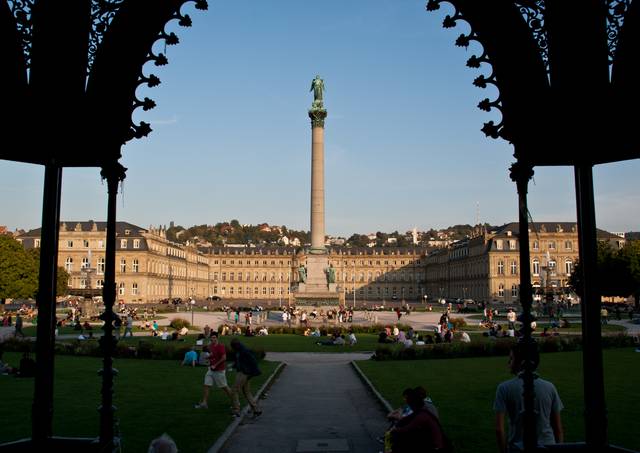
- Schlossplatz. The Schlossplatz is the largest square in Stuttgart, right in the middle of the Mitte in front of the Neues Schloss. It was created as parade grounds for the palace, and is now a public green area with lawns, flowerbeds, twin fountains and a decorative bandstand. It immediately adjoins the Koenigstraße, and a number of key buildings can be accessed immediately from it. In warmer months, the Schlossplatz is always full of locals, students and tourists enjoying its relaxing atmosphere.
- Neues Schloss. The arguably most recognizable symbol of Stuttgart was constructed between 1746 and 1807 when the Duke of Württemberg, Carl Eugen, found the Altes Schloss and the erstwhile ducal residence in Ludwigsburg to be insufficiently stately. The new palace was a grandiose undertaking that took many decades, architects and four successive Dukes of Württemberg to complete, given the ever-changing tastes and plans, as well as constant scandalization within the Duchy regarding the costs of the lavish residence.
The result is a palace inspired partially by Versailles and other grand royal residences, which gave the centre of Stuttgart an airy, garden park feel. The palace became a state museum in 1918 when the last King of Württemberg abdicated, and was almost completely destroyed in World War II. It was rebuilt in 1958-1964 to serve as a seat for the local government of Baden-Württemberg. It now houses the Ministry of Finance and Economy for the Land, and can be visited during guided tours. Tour dates are announced in advance on the palace's website, and visitors are invited to sign up. Several rooms and halls in the palace can also be rented for special events. Tours cost €8 per adult.

- Altes Schloss. Built as a fully-functional fortified castle at the turn of the 10th century, it grew together with Stuttgart as it rose from a small settlement to the capital of County, and later Duchy of Württemberg. It was in the 16th century that the castle got its current form of a renaissance palace with a cloistered courtyard. The moat around the Altes Schloss was filled in in the 18th century, and became today's Schillerplatz. Today the Altes Schloss houses the Landemuseum Württemberg.
- Alte Kanzlei. The construction of the mighty monument on the northeast side of the Schiller Square lasted three years from 1542 to 1544. Only 22 years later, in 1566, the construction of the building has been extended. Nowadays the Old Chancellery would be comparable to the function of a town hall. Today the building is used as a restaurant and a bar.
- Königsbau. The Königsbau was erected 1856-1860 directly in front of the Neues Schloss as a multi-functional building to host commerce and special events, at the order of King Wilhem I (hence the name, which means "king's building"). Its Schlossplatz facade, with 34 columns over 135 metres, serves as a balance to the equally imposing palace opposite. In the latter half of the 20th century, the rebuilt Königsbau became shortly the seat of Stuttgart's stock exchange, and a part of a large shopping centre called Königsbau Passagen, which extends behind the main building.
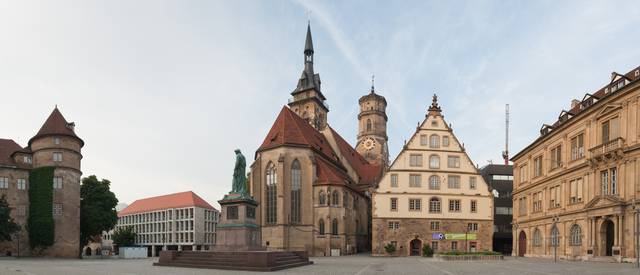
- Schillerplatz. Named after the great poet Friedrich Schiller, whose statue stands in the middle of the square.
- Stiftskirche. Built in 1175.
- Prinzenbau. Built 1750.
- Opernhaus. Pass the New Palace to the left and you find yourself in the beautiful Schlossgarten with the Opernhaus in front of a artificial lake, as part of the Staatstheater Stuttgart. Also the parliament of the state of Baden-Würrtemberg is there.
- Hauptbahnhof. The Railway Station was built in 1920 as a terminus station. The 56-meter-high tower with its rotating and illuminated Mercedes-Benz is one of the most famous city landmarks. On top of the tower there is an exhibition of the most controversial infrastructure project in Germany called S21. The plan is to convert the main line terminus station into an underground through station by turning the tracks with a 90-degree angle to the present station. It's free to climb up and grants awesome views of Königstraße and the city.
- Markthalle. A beautiful Jugendstil market hall built in 1910.
- Wilhelmspalais. (1834-1840)
Schlossplatz. The Schlossplatz is the largest square in Stuttgart, right in the middle of the Mitte in front of the Neues Schloss. It was created as parade grounds for the palace, and is now a public green area with lawns, flowerbeds, twin fountains and a decorative bandstand. It immediately adjoins the Koenigstraße, and a number of key buildings can be accessed immediately from it. In warmer months, the Schlossplatz is always full of locals, students and tourists enjoying its relaxing atmosphere.
Neues Schloss. The arguably most recognizable symbol of Stuttgart was constructed between 1746 and 1807 when the Duke of Württemberg, Carl Eugen, found the Altes Schloss and the erstwhile ducal residence in Ludwigsburg to be insufficiently stately. The new palace was a grandiose undertaking that took many decades, architects and four successive Dukes of Württemberg to complete, given the ever-changing tastes and plans, as well as constant scandalization within the Duchy regarding the costs of the lavish residence.
The result is a palace inspired partially by Versailles and other grand royal residences, which gave the centre of Stuttgart an airy, garden park feel. The palace became a state museum in 1918 when the last King of Württemberg abdicated, and was almost completely destroyed in World War II. It was rebuilt in 1958-1964 to serve as a seat for the local government of Baden-Württemberg. It now houses the Ministry of Finance and Economy for the Land, and can be visited during guided tours. Tour dates are announced in advance on the palace's website, and visitors are invited to sign up. Several rooms and halls in the palace can also be rented for special events. Tours cost €8 per adult.
Altes Schloss. Built as a fully-functional fortified castle at the turn of the 10th century, it grew together with Stuttgart as it rose from a small settlement to the capital of County, and later Duchy of Württemberg. It was in the 16th century that the castle got its current form of a renaissance palace with a cloistered courtyard. The moat around the Altes Schloss was filled in in the 18th century, and became today's Schillerplatz. Today the Altes Schloss houses the Landemuseum Württemberg.
Alte Kanzlei. The construction of the mighty monument on the northeast side of the Schiller Square lasted three years from 1542 to 1544. Only 22 years later, in 1566, the construction of the building has been extended. Nowadays the Old Chancellery would be comparable to the function of a town hall. Today the building is used as a restaurant and a bar.
Königsbau. The Königsbau was erected 1856-1860 directly in front of the Neues Schloss as a multi-functional building to host commerce and special events, at the order of King Wilhem I (hence the name, which means "king's building"). Its Schlossplatz facade, with 34 columns over 135 metres, serves as a balance to the equally imposing palace opposite. In the latter half of the 20th century, the rebuilt Königsbau became shortly the seat of Stuttgart's stock exchange, and a part of a large shopping centre called Königsbau Passagen, which extends behind the main building.
Schillerplatz. Named after the great poet Friedrich Schiller, whose statue stands in the middle of the square.
Stiftskirche. Built in 1175.
Prinzenbau. Built 1750.
Opernhaus. Pass the New Palace to the left and you find yourself in the beautiful Schlossgarten with the Opernhaus in front of a artificial lake, as part of the Staatstheater Stuttgart. Also the parliament of the state of Baden-Würrtemberg is there.
Hauptbahnhof. The Railway Station was built in 1920 as a terminus station. The 56-meter-high tower with its rotating and illuminated Mercedes-Benz is one of the most famous city landmarks. On top of the tower there is an exhibition of the most controversial infrastructure project in Germany called S21. The plan is to convert the main line terminus station into an underground through station by turning the tracks with a 90-degree angle to the present station. It's free to climb up and grants awesome views of Königstraße and the city.
Markthalle. A beautiful Jugendstil market hall built in 1910.
Wilhelmspalais. (1834-1840)
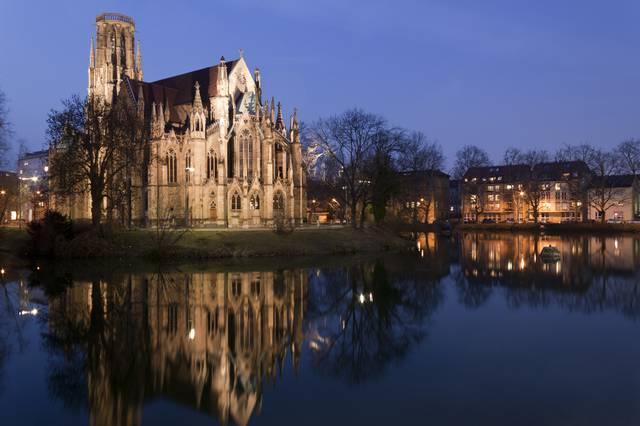
- Liederhalle. (1956)
- Johanneskirche. Although there is no Cologne Cathedral in Stuttgart, there are a few churches worth visiting. Most beautiful is the Johanneskirche, which is surrounded by the lake Feuersee and lighted at night. Other interesting churches are: Mätthauskirche (St. Matthew's Church), Domkirche St. Eberhard (St. Eberhard's Cathedral Church), Hospitalkirche (Hospital Church), Leonhardskirche (St. Leonard's Church), Veitskapelle (St. Vitus Chapel), St. Catherine's Church (English-speaking Anglican Church).
- Bohnenviertel. The Bohnenviertel is the only preserved part of Stuttgart's old town, having miraculously survived to the present day largely intact. Built mainly in the 14th century, it used to house the poorer part of the population, who fed mainly on beans which were grown all around the quarter in gardens and even hanging from the houses' walls, hence the name meaning "bean quarter". Today, the Bohnenviertel is thriving on artisanry and small, old-style retail, as well as gastronomy.
- Stadtbibliothek am Mailänder Platz. M-Sa 09:00-21:00. Stuttgart's city library moved into this spectacular new building in 2011. It took 13 years of planning, an international architectural competition (which was won by Eun Young Yi from South Korea) and €80 million to complete it. On the outside, it is a sombre, nine-storey cube with a glass-brick facade. Inside, the whitewashed surfaces and bright lighting provide an almost unreal ambiance. There is quite a lot of innovative features and facilities inside, not only related to the rather simple layout and fit-outs, but rather to the way the library itself works - for example, you can borrow not only books, but also works of art, or work with music and sound clips in the sound lab. There is also a cafe on the top floor (open 10:00-18:00), and you can get a free map and audioguide from the reception on the ground floor. Most facilities are free of charge, but to borrow books or media you will need to purchase at least a monthly pass for €4.
- Qingyin garden. 09:00 till dusk or 20:00, whichever comes sooner. A small Chinese garden, with a pond, ornamental walls and a mini-pagoda included, hidden on one of the hills close to the Hauptbahnhof.
Liederhalle. (1956)
Johanneskirche. Although there is no Cologne Cathedral in Stuttgart, there are a few churches worth visiting. Most beautiful is the Johanneskirche, which is surrounded by the lake Feuersee and lighted at night. Other interesting churches are: Mätthauskirche (St. Matthew's Church), Domkirche St. Eberhard (St. Eberhard's Cathedral Church), Hospitalkirche (Hospital Church), Leonhardskirche (St. Leonard's Church), Veitskapelle (St. Vitus Chapel), St. Catherine's Church (English-speaking Anglican Church).
Bohnenviertel. The Bohnenviertel is the only preserved part of Stuttgart's old town, having miraculously survived to the present day largely intact. Built mainly in the 14th century, it used to house the poorer part of the population, who fed mainly on beans which were grown all around the quarter in gardens and even hanging from the houses' walls, hence the name meaning "bean quarter". Today, the Bohnenviertel is thriving on artisanry and small, old-style retail, as well as gastronomy.
Stadtbibliothek am Mailänder Platz. M-Sa 09:00-21:00. Stuttgart's city library moved into this spectacular new building in 2011. It took 13 years of planning, an international architectural competition (which was won by Eun Young Yi from South Korea) and €80 million to complete it. On the outside, it is a sombre, nine-storey cube with a glass-brick facade. Inside, the whitewashed surfaces and bright lighting provide an almost unreal ambiance. There is quite a lot of innovative features and facilities inside, not only related to the rather simple layout and fit-outs, but rather to the way the library itself works - for example, you can borrow not only books, but also works of art, or work with music and sound clips in the sound lab. There is also a cafe on the top floor (open 10:00-18:00), and you can get a free map and audioguide from the reception on the ground floor. Most facilities are free of charge, but to borrow books or media you will need to purchase at least a monthly pass for €4.
Qingyin garden. 09:00 till dusk or 20:00, whichever comes sooner. A small Chinese garden, with a pond, ornamental walls and a mini-pagoda included, hidden on one of the hills close to the Hauptbahnhof.
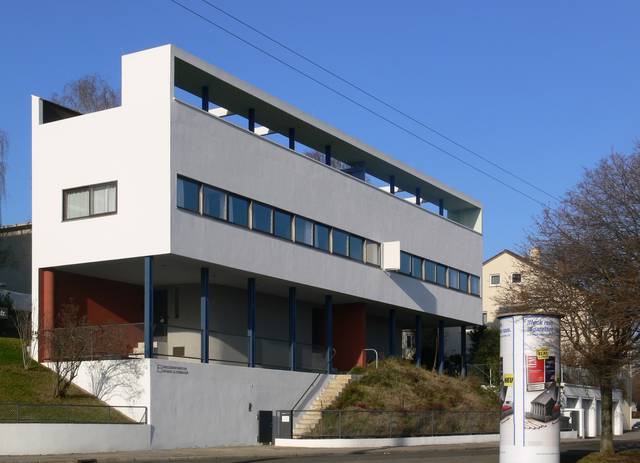

- Weissenhof Estate, Rathenaustraße 1- 3. Tu-F 11:00-18:00; Sa Su 10:00-18:00. A world heritage listed housing estate built for exhibition in 1927, features residential buildings by such famous architects like Le Corbusier, Peter Behrens, Walter Gropius and Ludwig Mies van der Rohe. In two semi-detached houses designed by Le Corbusier, there is a museum dedicated to the area. The historical building is not suitable for people using wheelchairs. normal ticket €5, reduced €2.
- Schloss Solitude. The Solitude palace was built as a hunting lodge and summer residence in in 1769 and looks from the outside like a classical rococo palace. It is on a high plain outside Stuttgart and offers views to the north. During the opening hours there are guidance every 45 minutes. Ask for English guidance. €4/€2.
- Old Town and Market in Bad Cannstatt. Bad Cannstatt is older than Stuttgart, and has been a thriving town when today's centre of Stuttgart was still a horse pasture. Moreover, unlike the centre of Stuttgart, the old town of Bad Cannstatt survived the Second World War relatively unscathed. Therefore, you can still get an authenthic, medieval feel wandering around its winding narrow streets, which all lead to a peculiarly-shaped market square.
On the market square, you will find the town church of Cannstatt (Stadtskirche) and the old town hall, still in use as the district's government seat (Bezirksrathaus), both from the late 15th century.-zaNqN.medium.jpg)
- Kurpark in Bad Cannstatt. Cannstatt owes the Bad in its name to numerous mineral water springs. To enable locals and visitors to enjoy them, a small but very peaceful Kurpark was arranged for in the 19th century, along with a large Kursaal (spa hall) building, which today is a restaurant and special event venue. Right next to it is the MineralBad-Cannstatt spa-wellness-fitness complex with a large pool covered by an impressive glass dome.
- Gottlieb Daimler Memorial, Taubenheimstraße 13 (Bad Cannstatt) (U2 station Kursaal. Tu-F 14:00-17:00, Sa Su and holidays 11:00-17:00, closed on Mondays. Stuttgart in general claims to be the birthplace of the automobile, but if you want to see the actual place where it was born, head to the Kurpark in Bad Cannstatt, where the garden house that Gottlieb Daimler converted into his workshop still stands. There he and Wilhelm Maybach worked in the latter half of the 19th century on combustion engines and motorized vehicles they have eventually so successfully developed. Today, it houses an exhibition maintained by Mercedes-Benz Classic that tells the story of the early days of the Daimler motor car company. Admission free.
Weissenhof Estate, Rathenaustraße 1- 3. Tu-F 11:00-18:00; Sa Su 10:00-18:00. A [[world heritage]] listed housing estate built for exhibition in 1927, features residential buildings by such famous architects like Le Corbusier, Peter Behrens, Walter Gropius and Ludwig Mies van der Rohe. In two semi-detached houses designed by Le Corbusier, there is a museum dedicated to the area. The historical building is not suitable for people using wheelchairs. normal ticket €5, reduced €2.
Schloss Solitude. The Solitude palace was built as a hunting lodge and summer residence in in 1769 and looks from the outside like a classical rococo palace. It is on a high plain outside Stuttgart and offers views to the north. During the opening hours there are guidance every 45 minutes. Ask for English guidance. €4/€2.
Old Town and Market in Bad Cannstatt. Bad Cannstatt is older than Stuttgart, and has been a thriving town when today's centre of Stuttgart was still a horse pasture. Moreover, unlike the centre of Stuttgart, the old town of Bad Cannstatt survived the Second World War relatively unscathed. Therefore, you can still get an authenthic, medieval feel wandering around its winding narrow streets, which all lead to a peculiarly-shaped market square.
On the market square, you will find the town church of Cannstatt (Stadtskirche) and the old town hall, still in use as the district's government seat (Bezirksrathaus), both from the late 15th century.
Kurpark in Bad Cannstatt. Cannstatt owes the Bad in its name to numerous mineral water springs. To enable locals and visitors to enjoy them, a small but very peaceful Kurpark was arranged for in the 19th century, along with a large Kursaal (spa hall) building, which today is a restaurant and special event venue. Right next to it is the MineralBad-Cannstatt spa-wellness-fitness complex with a large pool covered by an impressive glass dome.
Gottlieb Daimler Memorial, Taubenheimstraße 13 (Bad Cannstatt) (U2 station Kursaal. Tu-F 14:00-17:00, Sa Su and holidays 11:00-17:00, closed on Mondays. Stuttgart in general claims to be the birthplace of the automobile, but if you want to see the actual place where it was born, head to the Kurpark in Bad Cannstatt, where the garden house that Gottlieb Daimler converted into his workshop still stands. There he and Wilhelm Maybach worked in the latter half of the 19th century on combustion engines and motorized vehicles they have eventually so successfully developed. Today, it houses an exhibition maintained by Mercedes-Benz Classic that tells the story of the early days of the Daimler motor car company. Admission free.
Stuttgart is home of a wide range of very good museums including 5 state museums and two automobile museums.
- Staatsgalerie Stuttgart, Konrad-Adenauer-Str. 30-32. There are two exhibitions in different buildings. "Alte Staatsgalerie" ("Old": Art from 1500 to 1900) and "Neue Staatgalerie" ("New": Modern art). You can walk inside from one exhibition to the other. The permanent exhibits are free on Wednesdays and Saturdays.
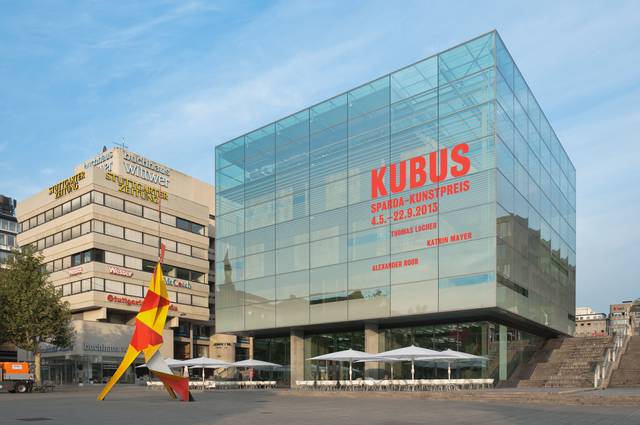
- Kunstmuseum Stuttgart, Kleiner Schlossplatz 1 (U-Bahn station Schlossplatz, +49 711 216 21 88. Tu-Su 10:00-18:00, Fridays till 21:00. Restaurant and bar open everyday until midnight. The simple glass cube of the Kunstmuseum contrasts with the lavish historic architecture of its surroundings, while not being intrusive thanks to its transparency. Its collection of modern art pieces is now over 15,000-strong, but obviously not all of them are displayed at the same time, but rather selected ones in temporary thematic exhibitions. Apart from exhibition spaces, the building hosts a large thematic bookstore, as well as a high-end restaurant Cube and o.T. bar, affording splendid views over the Schlossplatz. From €6, depending on exhibition. Small discounts for students. Guided tours €2.50 per person.
- Württembergisches Landesmuseum, Altes Schloss, Schillerplatz 6. Tu-Su 10:00-17:00. The Landesmuseum is a direct descendant of a collection of local antiquities formed in 1862 by King Wilhelm I of Württemberg, and since 1948 has the Altes Schloss as its main seat. The museum's collections are a potpourri of archeological artifacts and works of art from different periods, mostly related in one way or another to the region. This includes a large collection of folk art.While the museum actually manages many locations across Stuttgart and the entirety of Baden-Württemberg, it is in the Altes Schloss where the main exhibitions take place. There are small permanent exhibitions of a cross-section of the museum's collections, and temporary themed exhibitions in the Schloss. Permanent exhibition €5.50, temporary varies (around €12). The small permanent exhibition in the museum's foyer is free.
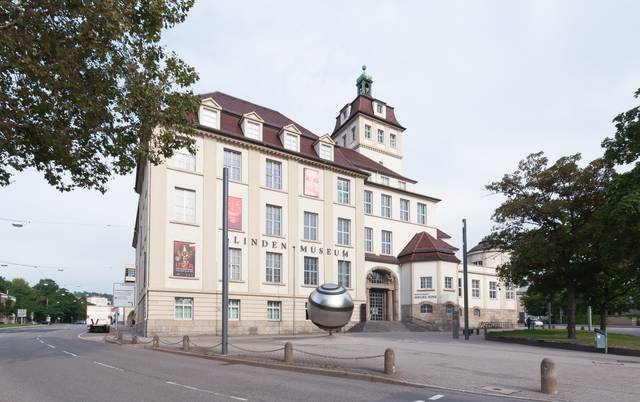
- Linden-Museum, Hegelplatz 1 (Bus 40 and 42, stop Hegelplatz/Linden-Museum. Tu-Su 10:00-18:00. The Museum is named after Karl von Linden, the president of the Württembergischer Verein für Handelsgeographie, who started the collection of various artifacts acquired from all corners of the world. The museum is housed in a purpose-built property from 1911, together with which it became a public property in 1973. There are permanent exhibitions devoted to all regions of the world except for Europe, as well as temporary thematic exhibitions. The on-site restaurant offers an exquisite menu in the evenings and a very affordable lunch menu on weekdays until 14:00. €4 for the permanent exhibition, around €12 for the temporary ones. Entry free for children under 12..
- Staatliches Museum für Naturkunde Stuttgart, Rosenstein 1. Two exhibitions: one features biology and evolution and the other features paleontology and archeology.
- Haus der Musik in Fruchkasten. The collection of Landesmuseum of local, European and extra-European instruments spanning centuries from prehistoric to contemporary is displayed in the historic Fruchtkasten, the granary in Schillerplatz. More than just a display of historic artifacts, the museum tries to engage and educate its visitors through temporary, thematic exhibitions and an interactive audioguide. Best of all, however, is the fact the entry, including the audioguide, is free.
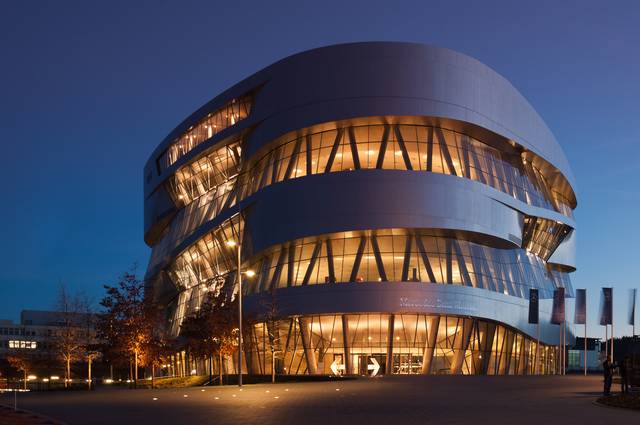
- Mercedes-Benz Museum, Mercedesstraße 100, Bad Cannstatt (S1, S2, S3 or a regional train to Stuttgart-Bad Cannstatt and then bus 56 (6 mins, 4 stops) - or S1 to Neckarpark (Mercedes-Benz) and walk 850 m south. Tu-Su 09:00-18:00, closed Mondays, ticket office closes at 17:00 everyday. Closed on Christmas and New Year's Day and their eves. Open on almost all other holidays. Built in 2006 in an astonishing architecture, the Mercedes-Benz museum houses a collection of automobiles built by the company over its long history. Both pioneering vehicles, significant technological breakthroughs as well as those significant for their participation in history (record-breaking or winning sportscars, cars used by famous personalities) are exhibited brilliantly.The museum ticket includes the use of an electronic audioguide, but the visit may be enhanced by a guided tour (extra €4), of which there is a variety to choose from. You can also combine your museum visit with a tour of the factory in Unterturkheim (€4, 90 min, Tu F 11:45 in English). There is an on-site cafe and high-class restaurant in the Museum and a museum shop. There are special events throughout the year, so do browse the page to see what is on on the days of your visit to Stuttgart. €8 regular entry, €4 reduced (children, students, anybody over 60); 50% of that if entry is after 16:30.
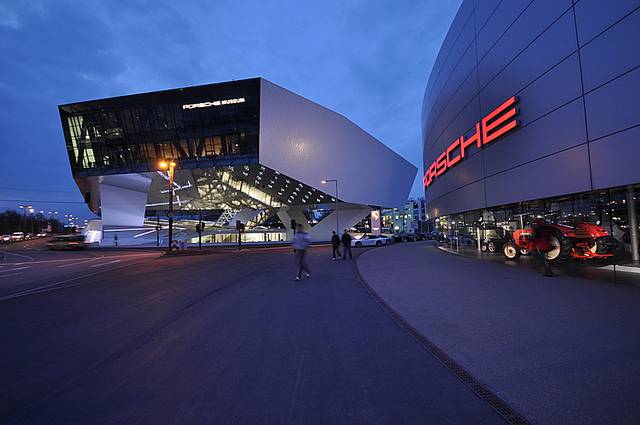
- Porsche Museum, Porscheplatz 1, Zuffenhausen (S6 to "Neuwirtshaus (Porscheplatz)". The building is an architectural marvel in itself, inside and out, but the highlights are obviously the exhibited examples of historic Porsche cars (and cars that Porsche designed for other companies, like the legendary Volkswagen "Beetle"), taken from Porsche's impressive collection of more than 500 historic and significant automobiles. A visit may be combined with a factory tour (you have to contact the museum to arrange for that). €8 regular entry, €4 reduced (children, students, anybody over 60); 50% of that if entry is after 17:00.
Staatsgalerie Stuttgart, Konrad-Adenauer-Str. 30-32. There are two exhibitions in different buildings. "Alte Staatsgalerie" ("Old": Art from 1500 to 1900) and "Neue Staatgalerie" ("New": Modern art). You can walk inside from one exhibition to the other. The permanent exhibits are free on Wednesdays and Saturdays.
Kunstmuseum Stuttgart, Kleiner Schlossplatz 1 (U-Bahn station Schlossplatz, +49 711 216 21 88. Tu-Su 10:00-18:00, Fridays till 21:00. Restaurant and bar open everyday until midnight. The simple glass cube of the Kunstmuseum contrasts with the lavish historic architecture of its surroundings, while not being intrusive thanks to its transparency. Its collection of modern art pieces is now over 15,000-strong, but obviously not all of them are displayed at the same time, but rather selected ones in temporary thematic exhibitions. Apart from exhibition spaces, the building hosts a large thematic bookstore, as well as a high-end restaurant Cube and o.T. bar, affording splendid views over the Schlossplatz. From €6, depending on exhibition. Small discounts for students. Guided tours €2.50 per person.
Württembergisches Landesmuseum, Altes Schloss, Schillerplatz 6. Tu-Su 10:00-17:00. The Landesmuseum is a direct descendant of a collection of local antiquities formed in 1862 by King Wilhelm I of Württemberg, and since 1948 has the Altes Schloss as its main seat. The museum's collections are a potpourri of archeological artifacts and works of art from different periods, mostly related in one way or another to the region. This includes a large collection of folk art.While the museum actually manages many locations across Stuttgart and the entirety of Baden-Württemberg, it is in the Altes Schloss where the main exhibitions take place. There are small permanent exhibitions of a cross-section of the museum's collections, and temporary themed exhibitions in the Schloss. Permanent exhibition €5.50, temporary varies (around €12). The small permanent exhibition in the museum's foyer is free.
Linden-Museum, Hegelplatz 1 (Bus 40 and 42, stop Hegelplatz/Linden-Museum. Tu-Su 10:00-18:00. The Museum is named after Karl von Linden, the president of the Württembergischer Verein für Handelsgeographie, who started the collection of various artifacts acquired from all corners of the world. The museum is housed in a purpose-built property from 1911, together with which it became a public property in 1973. There are permanent exhibitions devoted to all regions of the world except for Europe, as well as temporary thematic exhibitions. The on-site restaurant offers an exquisite menu in the evenings and a very affordable lunch menu on weekdays until 14:00. €4 for the permanent exhibition, around €12 for the temporary ones. Entry free for children under 12..
Staatliches Museum für Naturkunde Stuttgart, Rosenstein 1. Two exhibitions: one features biology and evolution and the other features paleontology and archeology.
Haus der Musik in Fruchkasten. The collection of Landesmuseum of local, European and extra-European instruments spanning centuries from prehistoric to contemporary is displayed in the historic Fruchtkasten, the granary in Schillerplatz. More than just a display of historic artifacts, the museum tries to engage and educate its visitors through temporary, thematic exhibitions and an interactive audioguide. Best of all, however, is the fact the entry, including the audioguide, is free.
Mercedes-Benz Museum, Mercedesstraße 100, Bad Cannstatt (S1, S2, S3 or a regional train to Stuttgart-Bad Cannstatt and then bus 56 (6 mins, 4 stops) - or S1 to Neckarpark (Mercedes-Benz) and walk 850 m south. Tu-Su 09:00-18:00, closed Mondays, ticket office closes at 17:00 everyday. Closed on Christmas and New Year's Day and their eves. Open on almost all other holidays. Built in 2006 in an astonishing architecture, the Mercedes-Benz museum houses a collection of automobiles built by the company over its long history. Both pioneering vehicles, significant technological breakthroughs as well as those significant for their participation in history (record-breaking or winning sportscars, cars used by famous personalities) are exhibited brilliantly.The museum ticket includes the use of an electronic audioguide, but the visit may be enhanced by a guided tour (extra €4), of which there is a variety to choose from. You can also combine your museum visit with a tour of the factory in Unterturkheim (€4, 90 min, Tu F 11:45 in English). There is an on-site cafe and high-class restaurant in the Museum and a museum shop. There are special events throughout the year, so do browse the page to see what is on on the days of your visit to Stuttgart. €8 regular entry, €4 reduced (children, students, anybody over 60); 50% of that if entry is after 16:30.
Porsche Museum, Porscheplatz 1, Zuffenhausen (S6 to "Neuwirtshaus (Porscheplatz)". The building is an architectural marvel in itself, inside and out, but the highlights are obviously the exhibited examples of historic Porsche cars (and cars that Porsche designed for other companies, like the legendary Volkswagen "Beetle"), taken from Porsche's impressive collection of more than 500 historic and significant automobiles. A visit may be combined with a factory tour (you have to contact the museum to arrange for that). €8 regular entry, €4 reduced (children, students, anybody over 60); 50% of that if entry is after 17:00.
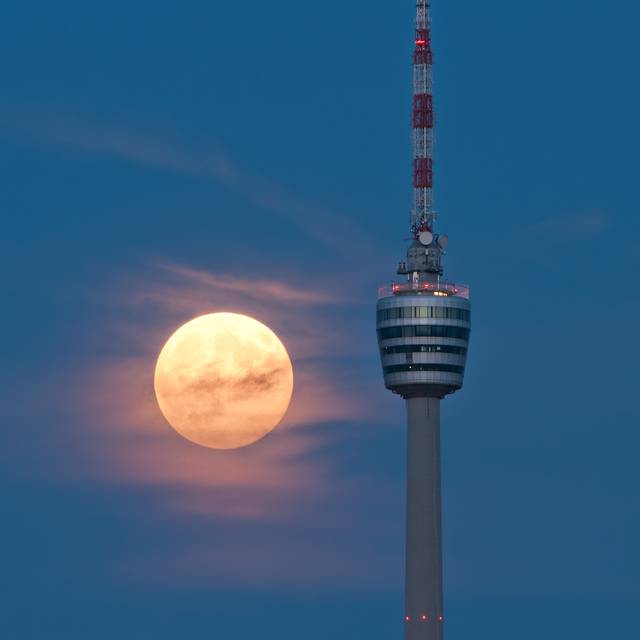 Stuttgart is picturesquely located in a valley surrounded by green hills, which the locals call Kessel, or a cauldron. Therefore, one of the main attractions are the views from the hillsides and hilltops around the city. There are several options to enjoy an extraordinary view over the Swabian capital:
Stuttgart is picturesquely located in a valley surrounded by green hills, which the locals call Kessel, or a cauldron. Therefore, one of the main attractions are the views from the hillsides and hilltops around the city. There are several options to enjoy an extraordinary view over the Swabian capital:
- Fernsehturm Stuttgart. The world's first TV tower constructed from reinforced concrete was built from 1954-1956. It is the prototype for all modern TV towers, and affords visitors a beautiful view over Stuttgart. The Stadtbahn U15 to Ruhbank (Fernsehturm) gives you a wonderful view of the city. Entrance is €7 per person and is worth it for the near-fairground quality of the ride in the lift to the top. There's a nice cafe at the top which serves fresh food and drinks.
- Bismarckturm. A small tower northwest of the city centre, not far from Killesberg Tower
- Grabkapelle Württemberg. The Württemberg Mausoleum stands in Rotenberg on the peak of the Württemberg Hill overlooking the Neckar river. The memorial was built for Catherine Pavlovna of Russia, the second wife of William I of Württemberg. The remains of William I and his daughter Maria Friederike Charlotte of Württemberg are also housed in the mausoleum. The mausoleum was constructed between 1820 and 1824 based on a design drafted by Giovanni Salucci.
- Karlshöhe. A hill that separates the western and southern city. Walk uphill 10 minutes southern from S-Bahn-Station "Feuersee" through a park (via Senefelder Str, right to Reinsburgstr, left to Jean-Améry-Weg). Have an outlook and enjoy the beer garden.
- Weißenburgpark. A hill opposite to the Karlshöhe. Easy approach: it is a short hop from Station "Bopser" (U5, U6, U7). Outlook and nice Jugendstil-restaurant and beer garden (closes at 23:00)
- Birkenkopf. A debris mountain made of 15 million m³ of rubble from World War II as a memorial to everyone who died in the war. It is the highest point in Stuttgart.
- Killesbergturm. A tower in the "Killesberg Park" (see also "green U" under Parks & Gardens), north of the city centre.
Fernsehturm Stuttgart. The world's first TV tower constructed from reinforced concrete was built from 1954-1956. It is the prototype for all modern TV towers, and affords visitors a beautiful view over Stuttgart. The Stadtbahn U15 to Ruhbank (Fernsehturm) gives you a wonderful view of the city. Entrance is €7 per person and is worth it for the near-fairground quality of the ride in the lift to the top. There's a nice cafe at the top which serves fresh food and drinks.
Bismarckturm. A small tower northwest of the city centre, not far from Killesberg Tower
Grabkapelle Württemberg. The Württemberg Mausoleum stands in Rotenberg on the peak of the Württemberg Hill overlooking the Neckar river. The memorial was built for Catherine Pavlovna of Russia, the second wife of William I of Württemberg. The remains of William I and his daughter Maria Friederike Charlotte of Württemberg are also housed in the mausoleum. The mausoleum was constructed between 1820 and 1824 based on a design drafted by Giovanni Salucci.
Karlshöhe. A hill that separates the western and southern city. Walk uphill 10 minutes southern from S-Bahn-Station "Feuersee" through a park (via Senefelder Str, right to Reinsburgstr, left to Jean-Améry-Weg). Have an outlook and enjoy the beer garden.
Weißenburgpark. A hill opposite to the Karlshöhe. Easy approach: it is a short hop from Station "Bopser" (U5, U6, U7). Outlook and nice Jugendstil-restaurant and beer garden (closes at 23:00)
Birkenkopf. A debris mountain made of 15 million m³ of rubble from World War II as a memorial to everyone who died in the war. It is the highest point in Stuttgart.
Killesbergturm. A tower in the "Killesberg Park" (see also "green U" under Parks & Gardens), north of the city centre.
"Das Grüne U": Most of Stuttgart's many parks and gardens are usually referred to by locals as "das Grüne U" (the green "U") because of the U-shaped form in which they are located around the city centre. They form a long and beautiful path around the city, starting at the Schlossgarten at the northern façade of the new palace (Neues Schloss), continuing through Rosensteinpark with the natural history museum and a rear entrance to Wilhelma (the zoo), and ending in Killesberg Park. Walking at a reasonable pace, you can walk the entire circuit in about 2 hours. There are beer gardens (look for Biergarten signs) and restaurants along the way, and the Killesberg Park is a real treat. It was designed for a huge botanical expo several years ago and remains a truly stunning park, especially in spring when in full bloom. If you're interested in architecture, be sure not to miss the structural engineering wonder Killesberg Tower, a minimalistic steel construction composed of one central support and a cable outer support system.
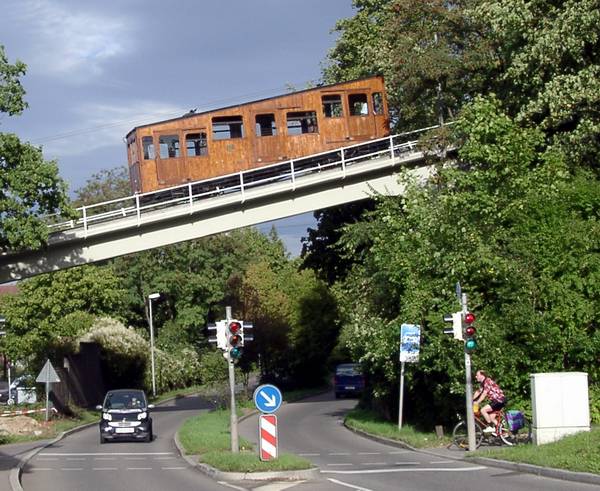
- Killesberg Railway, a small railway in Killesberg park, on weekends using steam-powered engines!
- Stuttgart Cable Car, an old cable car running to the forest cemetery
- Rack Railway Stuttgart, Germany's only urban rack-railway. It uses modern cars like the light railway and offers a nice view
- Zoo Wilhelma, Neckartalstraße, Bad Cannstatt. Definitely a must for families. But watching monkeys and weird flowers in this old place can be fun for young adults, too. (Unless you feel pity for the locked up creatures.) Wilhelma is also worth visiting for its architecture and landscaping features - the core of Wilhelma is housed in a 19th-century palace and park landscape in the Moorish style, created for and named after the former king Wilhelm of Wuerttemberg.
- Planetarium. A fascinating astronomical journey, projected by optical hightech equipment: Carl Zeiss Planetarium . Almost all the shows conducted here are in German. You may have to check with the office for English show timings.
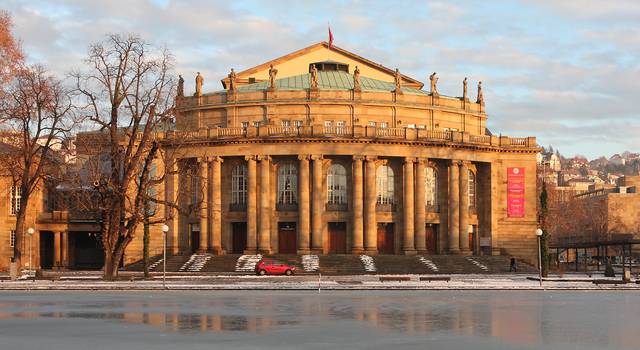
- The Stuttgart Ballet. Watch and listen to the ballet company of the state theater Stuttgart. It is one of the world's best ensembles founded by legacy of John Cranko. Definitely a top place to go to in the evening. You'll need to reserve tickets in advance.
- SI-Centrum. There are two musical theaters (Apollo-Theater and Stage Palladium Theater) in the hotel/conference/entertainment complex called the SI-Centrum (Stuttgart Musical Center) in Möhringen close to the A8. This complex includes also the Millennium hotel and a spacious underground complex that houses many conference rooms, bars, restaurants, a casino and a huge wellness pool area.
- Wagenhallen. Around 80 creative artists, architects, designers and musicians present their work in an old train depot and discarded train wagon.
- Corso Cinema International, Hauptstraße 6 Vaihingen (S-Bahn Vaihingen. Most cinemas will run movies with synchronized German voice-over/dubbing and you will be unable to enjoy the movie unless you understand German. CORSO Cinema International in Vaihingen shows movies with original audio track (and possibly German text captions). €7.80 for adults.
Zoo Wilhelma, Neckartalstraße, Bad Cannstatt. Definitely a must for families. But watching monkeys and weird flowers in this old place can be fun for young adults, too. (Unless you feel pity for the locked up creatures.) Wilhelma is also worth visiting for its architecture and landscaping features - the core of Wilhelma is housed in a 19th-century palace and park landscape in the Moorish style, created for and named after the former king Wilhelm of Wuerttemberg.
Planetarium. A fascinating astronomical journey, projected by optical hightech equipment: Carl Zeiss Planetarium . Almost all the shows conducted here are in German. You may have to check with the office for English show timings.
The Stuttgart Ballet. Watch and listen to the ballet company of the state theater Stuttgart. It is one of the world's best ensembles founded by legacy of John Cranko. Definitely a top place to go to in the evening. You'll need to reserve tickets in advance.
SI-Centrum. There are two musical theaters (Apollo-Theater and Stage Palladium Theater) in the hotel/conference/entertainment complex called the SI-Centrum (Stuttgart Musical Center) in Möhringen close to the A8. This complex includes also the Millennium hotel and a spacious underground complex that houses many conference rooms, bars, restaurants, a casino and a huge wellness pool area.
Wagenhallen. Around 80 creative artists, architects, designers and musicians present their work in an old train depot and discarded train wagon.
Corso Cinema International, Hauptstraße 6 Vaihingen (S-Bahn Vaihingen. Most cinemas will run movies with synchronized German voice-over/dubbing and you will be unable to enjoy the movie unless you understand German. CORSO Cinema International in Vaihingen shows movies with original audio track (and possibly German text captions). €7.80 for adults.
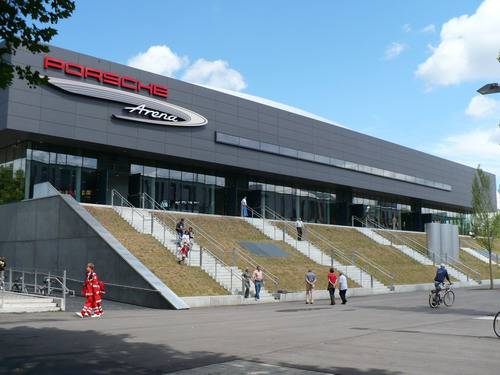
- Swim and relax. 06:00-21:00. Stuttgart is fond of its mineral springs, the biggest in Western Europe. The best one might be the Leuze Mineralbad which also offers a sauna, but there are many others like the Höhenfreibad Killesberg (open-air pool for €4.10) or the MineralBad Cannstatt. €8-15.
- Walk the wine trail. The Stuttgart wine trail. The Obertürkheim - Uhlbach - Rotenberg - Untertürkheim trail includes a viniculture museum, the Grabkapelle Württemberg (Burial chapel Württemberg) and restaurants where you can try the local wine.
- Watch Football. See the city's most famous sports team, the Fussball Bundesliga Club VfB Stuttgart in action. The club's home ground, the Mercedes-Benz-Arena, is in the Bad Cannstatt district, in the same neighborhood as the Mercedes-Benz Museum and the Volksfest takes place in autumn.
- Watch Tennis. International ladies' tennis (WTA's Porsche Grand Prix) can be seen in the Porsche Arena in September/October each year. This prestigious event attracts top players, with large prize-money and a new Porsche car on offer to the winner.
- Biking. The city lies in a basin of a hilly region the Stuttgarters call "Kessel", literally "cauldron", and between the lowest part of the city and the highest part of the city are 250 m of altitude. There is a lot of car traffic, and routes for bikes are not well developed. Biking in the outlying areas of Stuttgart, e.g. in the Neckar Valley or the Schönbuch (just south of the city) is very nice. Stuttgart is one of the greenest urban areas in Europe. There are many paths through the surrounding forests which are in very good shape.
Swim and relax. 06:00-21:00. Stuttgart is fond of its mineral springs, the biggest in Western Europe. The best one might be the Leuze Mineralbad which also offers a sauna, but there are many others like the Höhenfreibad Killesberg (open-air pool for €4.10) or the MineralBad Cannstatt. €8-15.
Walk the wine trail. The Stuttgart wine trail. The Obertürkheim - Uhlbach - Rotenberg - Untertürkheim trail includes a viniculture museum, the Grabkapelle Württemberg (Burial chapel Württemberg) and restaurants where you can try the local wine.
Watch Football. See the city's most famous sports team, the Fussball Bundesliga Club VfB Stuttgart in action. The club's home ground, the Mercedes-Benz-Arena, is in the Bad Cannstatt district, in the same neighborhood as the Mercedes-Benz Museum and the Volksfest takes place in autumn.
Watch Tennis. International ladies' tennis (WTA's Porsche Grand Prix) can be seen in the Porsche Arena in September/October each year. This prestigious event attracts top players, with large prize-money and a new Porsche car on offer to the winner.
Biking. The city lies in a basin of a hilly region the Stuttgarters call "Kessel", literally "cauldron", and between the lowest part of the city and the highest part of the city are 250 m of altitude. There is a lot of car traffic, and routes for bikes are not well developed. Biking in the outlying areas of Stuttgart, e.g. in the Neckar Valley or the Schönbuch (just south of the city) is very nice. Stuttgart is one of the greenest urban areas in Europe. There are many paths through the surrounding forests which are in very good shape.
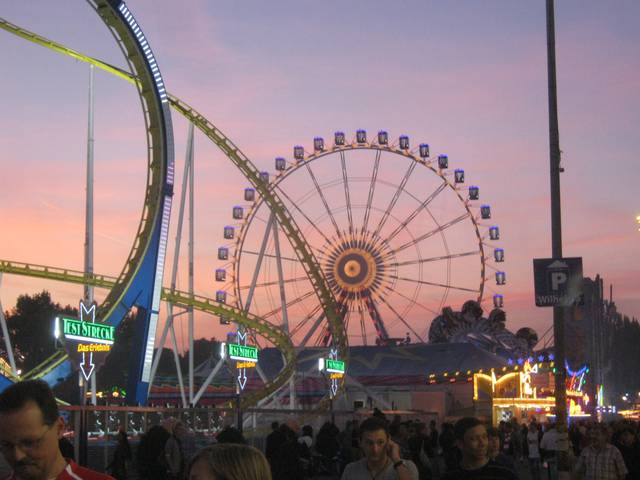
- Volksfest. Huge fun fair on the Cannstatter Wasen, beertents and rollercoasters, late September-early October. (Families should go there during daytime: after 20:00 o'clock beware of tough public and drunken people.) Canstatter Wasen is the second largest fun fair in the world. Visiting it is more pleasant than the Oktoberfest in Munich, because tents are not so overcrowded like on the Oktoberfest. Free entrance.
- Weindorf. Huge wine festival at 10 days in early September. More than one million visitors from all over the world try around 5000 different sorts of wine.
- Weihnachtsmarkt. Huge Christmas market during December.
- Stuttgarter Frühlingsfest. a fun fair like Cannstatter Wasen in April/May, but smaller. Free entrance.
- Festival of Animated Film. every year, April or May
- Long Night of the Museums. All museums open up to Sunday 02:00 in the morning. There is also a Long Night of Sciences (Lange Nacht der Wissenschaften) €16.
- Stuttgart Jazz Open. Festival in mid-July lasting about one week featuring American, European and other international performers at two downtown venues, one outdoor near the main train station and one indoor at a jazz club.
- Hamburg Fish Market. 10-day festival featuring seafood, beer, and vendors from the northern port city of Hamburg. The market fills Karlsplatz near the Schlossplatz in mid-July.
- Stuttgart Summer Festival. Early August, city centre - music, food and drinks.
- Bohnenviertelfest. Downtown street music festival in mid-July - music, food, drinks.
- International Festival of Science Fiction, Horror and Thriller. Late July or early August: Festival for strange films, one week of Horror, Splatter, Asia, Suspense, Action and Animation.
Volksfest. Huge fun fair on the Cannstatter Wasen, beertents and rollercoasters, late September-early October. (Families should go there during daytime: after 20:00 o'clock beware of tough public and drunken people.) Canstatter Wasen is the second largest fun fair in the world. Visiting it is more pleasant than the Oktoberfest in Munich, because tents are not so overcrowded like on the Oktoberfest. Free entrance.
Weindorf. Huge wine festival at 10 days in early September. More than one million visitors from all over the world try around 5000 different sorts of wine.
Weihnachtsmarkt. Huge Christmas market during December.
Stuttgarter Frühlingsfest. a fun fair like Cannstatter Wasen in April/May, but smaller. Free entrance.
Festival of Animated Film. every year, April or May
Long Night of the Museums. All museums open up to Sunday 02:00 in the morning. There is also a Long Night of Sciences (Lange Nacht der Wissenschaften) €16.
Stuttgart Jazz Open. Festival in mid-July lasting about one week featuring American, European and other international performers at two downtown venues, one outdoor near the main train station and one indoor at a jazz club.
Hamburg Fish Market. 10-day festival featuring seafood, beer, and vendors from the northern port city of Hamburg. The market fills Karlsplatz near the Schlossplatz in mid-July.
Stuttgart Summer Festival. Early August, city centre - music, food and drinks.
Bohnenviertelfest. Downtown street music festival in mid-July - music, food, drinks.
International Festival of Science Fiction, Horror and Thriller. Late July or early August: Festival for strange films, one week of Horror, Splatter, Asia, Suspense, Action and Animation.
From Stuttgart you can arrange many nice day trips:
- Ship roundtrips on river Neckar, Shipstop at Zoo Wilhelma Neckartalstraße, +49 711 54 99 70 60. Enjoy liner trips on the Neckar, roundtrips or event trips. Or charter a complete ship just for you. Season is from Easter till end of October. For the conditions see the website. Beverage and food is offered on the ships.
- Mercedes-Benz factory, Sindelfingen (Catch the S1 (S-bahn) to Boblingen, then catch the courtesy bus. The heart of Mercedes-Benz manufacture, and well worth the visit. There are some 40,000 employees on site, including 9,000 in research & development alone! There are also guided tour in English.
Ship roundtrips on river Neckar, Shipstop at Zoo Wilhelma Neckartalstraße, +49 711 54 99 70 60. Enjoy liner trips on the Neckar, roundtrips or event trips. Or charter a complete ship just for you. Season is from Easter till end of October. For the conditions see the website. Beverage and food is offered on the ships.
Mercedes-Benz factory, Sindelfingen (Catch the S1 (S-bahn) to Boblingen, then catch the courtesy bus. The heart of Mercedes-Benz manufacture, and well worth the visit. There are some 40,000 employees on site, including 9,000 in research & development alone! There are also guided tour in English.
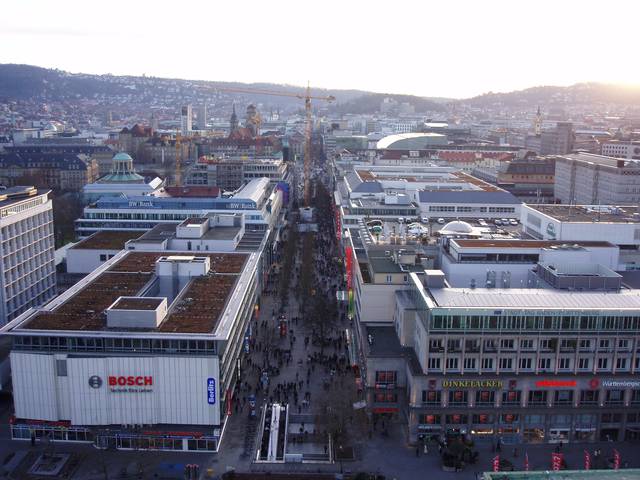
The main shopping street in Stuttgart is the Königstraße which starts at the main railway station. Left and right of Königstraße are interesting shops, too, but Königstraße is a good startpoint for navigation in the inner city. Stores and shops usually open their doors M-Sa 10:00 to 20:00.
- Das Gerber, Sophienstraße 21 (S/U-Bahn station Rotebühlplatz. 09:30-20:00. In September 2014, this shopping mall with 86 international brands opened extending the Königstraße. There are clothing shops, a food court and two supermarkets inside the building.
- Milaneo. M-Th 10:00-20:00; F 10:00-21:30; Sa 09:30-20:00. Opened in Ocotober 2014 this new shopping mall north of the main station is the largest of its kind in Baden-Württemberg. In the three connected buildings there are more than 200 shops and plenty of eating options.
- Königsbaupassagen. A modern shopping centre inside the historical Königsbau in the middle of the city at the Schlossplatz with a number of apparel chain stores and a food court.
- Breuninger, Marktstr. 1-3 (U1, U2, U4 and buses 43, 44, station/stop Rathaus. M-Sa 10:00-20:00, Saturdays from 09:30. Breuninger is Stuttgart's homegrown department store, which now has outlets in many other German cities and became one of only three surviving major department store chains, alongside Kaufhof and Karstad. The secret of their success is focusing on high-end fashion and other branded premium/luxury goods.
In Breuninger's Stuttgart flagship store, you will find a selection of local German and global brands in both apparel, accessories, sportsgear, cosmetics and home decoration spread over six levels. There are multiple restaurants/cafes, hairdressers' and a cosmetic treatment salon on site. Parking is provided across the Hauptstatter Straße with an underground passage from the garage to the store. - Galeria Kaufhof. Kaufhof is one of the two traditional department store chains in Germany, offering a broad range of consumer goods (apparel, sports gear, household goods, media and some foodstuffs) at midmarket prices. They have three locations throughout Stuttgart.
Das Gerber, Sophienstraße 21 (S/U-Bahn station Rotebühlplatz. 09:30-20:00. In September 2014, this shopping mall with 86 international brands opened extending the Königstraße. There are clothing shops, a food court and two supermarkets inside the building.
Milaneo. M-Th 10:00-20:00; F 10:00-21:30; Sa 09:30-20:00. Opened in Ocotober 2014 this new shopping mall north of the main station is the largest of its kind in Baden-Württemberg. In the three connected buildings there are more than 200 shops and plenty of eating options.
Königsbaupassagen. A modern shopping centre inside the historical Königsbau in the middle of the city at the Schlossplatz with a number of apparel chain stores and a food court.
Breuninger, Marktstr. 1-3 (U1, U2, U4 and buses 43, 44, station/stop Rathaus. M-Sa 10:00-20:00, Saturdays from 09:30. Breuninger is Stuttgart's homegrown department store, which now has outlets in many other German cities and became one of only three surviving major department store chains, alongside Kaufhof and Karstad. The secret of their success is focusing on high-end fashion and other branded premium/luxury goods.
In Breuninger's Stuttgart flagship store, you will find a selection of local German and global brands in both apparel, accessories, sportsgear, cosmetics and home decoration spread over six levels. There are multiple restaurants/cafes, hairdressers' and a cosmetic treatment salon on site. Parking is provided across the Hauptstatter Straße with an underground passage from the garage to the store.
Galeria Kaufhof. Kaufhof is one of the two traditional department store chains in Germany, offering a broad range of consumer goods (apparel, sports gear, household goods, media and some foodstuffs) at midmarket prices. They have three locations throughout Stuttgart.
- Galeria Kaufhof Eberhardtstraße.
- Galeria Kaufhof Königstraße.
- Galeria Kaufhof Bad Canstatt.
Galeria Kaufhof. Kaufhof is one of the two traditional department store chains in Germany, offering a broad range of consumer goods (apparel, sports gear, household goods, media and some foodstuffs) at midmarket prices. They have three locations throughout Stuttgart.
- Galeria Kaufhof Eberhardtstraße.
- Galeria Kaufhof Königstraße.
- Galeria Kaufhof Bad Canstatt.
Galeria Kaufhof. Kaufhof is one of the two traditional department store chains in Germany, offering a broad range of consumer goods (apparel, sports gear, household goods, media and some foodstuffs) at midmarket prices. They have three locations throughout Stuttgart.
- Galeria Kaufhof Eberhardtstraße.
- Galeria Kaufhof Königstraße.
- Galeria Kaufhof Bad Canstatt.
Galeria Kaufhof. Kaufhof is one of the two traditional department store chains in Germany, offering a broad range of consumer goods (apparel, sports gear, household goods, media and some foodstuffs) at midmarket prices. They have three locations throughout Stuttgart.
- Galeria Kaufhof Eberhardtstraße.
- Galeria Kaufhof Königstraße.
- Galeria Kaufhof Bad Canstatt.
- Abseits, Kleiner Schlossplatz 13/15 (Behind the Kunstmuseum.. M-F 10:00-20, Sa 10:00-19:00. Mostly casual, trendy designer clothes, shoes and accessories for both women and men. Carries merchandise starting at €300 apiece, unless there is a sale.
- Dorotheenquartier, Sporerstraße 11. New quarter with shops like Tiger of Sweden, Louis Vuitton, Gap, and Diesel. Quite expensive.
- Bungalow Gallery, Stiftstraße 1A, +49 711 220 2000. One of the best German clothes stores with designer labels (Acne, Bottega Veneta, Moncler, the White Briefs and many others) catering to women and men.
- Geschwisterliebe. A boutique carrying streetwear by young designers from all over Europe. Most pieces affordably priced below €100.
- SportScheck Stuttgart, Kronenstraße 3 (at the corner of Koenigstraße, +49 711 305 841 19. M-Sa 10:00-20:00. A part of a chain of stores carrying sport shoes, clothing and equipment. A large selection displayed over four stories.
Abseits, Kleiner Schlossplatz 13/15 (Behind the Kunstmuseum.. M-F 10:00-20, Sa 10:00-19:00. Mostly casual, trendy designer clothes, shoes and accessories for both women and men. Carries merchandise starting at €300 apiece, unless there is a sale.
Dorotheenquartier, Sporerstraße 11. New quarter with shops like Tiger of Sweden, Louis Vuitton, Gap, and Diesel. Quite expensive.
Bungalow Gallery, Stiftstraße 1A, +49 711 220 2000. One of the best German clothes stores with designer labels (Acne, Bottega Veneta, Moncler, the White Briefs and many others) catering to women and men.
Geschwisterliebe. A boutique carrying streetwear by young designers from all over Europe. Most pieces affordably priced below €100.
SportScheck Stuttgart, Kronenstraße 3 (at the corner of Koenigstraße, +49 711 305 841 19. M-Sa 10:00-20:00. A part of a chain of stores carrying sport shoes, clothing and equipment. A large selection displayed over four stories.
- Cheap Trash Records.
- Ratzer Records.
- Second Hand Records.
- Saturn.
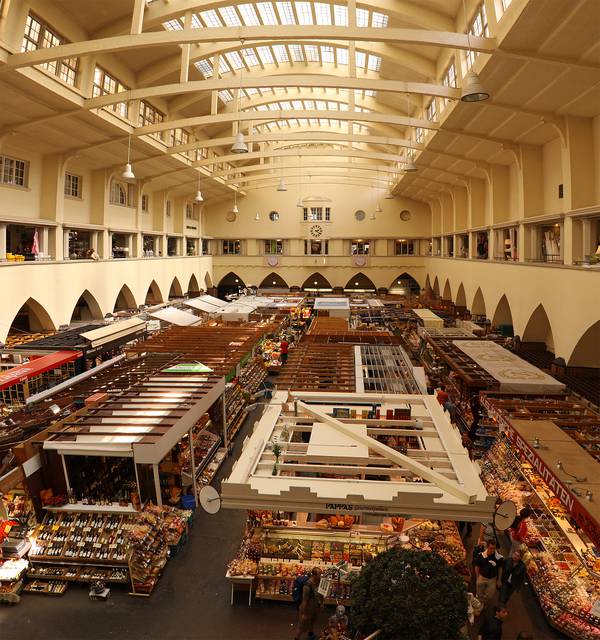
Cheap Trash Records.
Ratzer Records.
Second Hand Records.
Saturn.
There are weekly food markets in almost every district. Days and opening times vary a lot. To get an overview on the website of Stuttgarter Wochenmärkte
- Marktplatz am Rathaus. Public market on Tuesday, Thursday and Saturday mornings
- Wilhelmsplatz. Somewhat smaller public food market on Friday.
- Markthalle. Exotic wares, exotic prices, crowded.
Marktplatz am Rathaus. Public market on Tuesday, Thursday and Saturday mornings
Wilhelmsplatz. Somewhat smaller public food market on Friday.
Markthalle. Exotic wares, exotic prices, crowded.
There are restaurants all over Stuttgart. The traditional Swabian cuisine with onion-topped roast pork, think noodles called "Spätzle" or Maultaschen (stuffed noodles) is very tasty. Of course there are also restaurants serving styles from many other parts of the world.
Stuttgart publishes a book annually entitled Stuttgart geht aus (Stuttgart goes out). This is available at most book stores on Königstraße (e.g. Wittwer). This book, published in German, is a great guide to restaurants in the city.
- Café Camäleon. The south-west of Germany is known for the best Brezels. Very common are "Butterbrezel" with some butter on it. Try the traditional bakery Hafendörfer in the Eberhardstraße with the attached Café Camäleon. Other than that you'll find them in every bakery and also on the small wooden cabins on Königstraße.
- Dilan Kebab. There are döner (excellent Turkish fast-food) stands all over the city, plenty of them around the Rotebühlplatz. Take care to order "mit scharf" (dried chili, hot) or "ohne scharf" (not hot). "Mit scharf" and "ohne scharf" are incorrect German and would literally translate to either "with spicy" or "without spicy". Instead, "scharf" (spicy) or "nicht scharf" (not spicy) would be proper German.
- Veggie Voodoo King. A great vegan falafel shop.
- Udo Snack. Of course McDonald's, Burger King and Subway are in town, too. If you want to try their locally renowned single shop competitor, go to Udo Snack in Calwer Straße or XXL Burger on Steinstr., which is run by an old couple.
- Lou’s Maultäschle. Street vans that can be found in different locations around the city depending on the day of the week. Great Maultaschen.
Café Camäleon. The south-west of Germany is known for the best Brezels. Very common are "Butterbrezel" with some butter on it. Try the traditional bakery Hafendörfer in the Eberhardstraße with the attached Café Camäleon. Other than that you'll find them in every bakery and also on the small wooden cabins on Königstraße.
Dilan Kebab. There are döner (excellent Turkish fast-food) stands all over the city, plenty of them around the Rotebühlplatz. Take care to order "mit scharf" (dried chili, hot) or "ohne scharf" (not hot). "Mit scharf" and "ohne scharf" are incorrect German and would literally translate to either "with spicy" or "without spicy". Instead, "scharf" (spicy) or "nicht scharf" (not spicy) would be proper German.
Veggie Voodoo King. A great vegan falafel shop.
Udo Snack. Of course McDonald's, Burger King and Subway are in town, too. If you want to try their locally renowned single shop competitor, go to Udo Snack in Calwer Straße or XXL Burger on Steinstr., which is run by an old couple.
Lou’s Maultäschle. Street vans that can be found in different locations around the city depending on the day of the week. Great Maultaschen.
- Carls Brauhaus. Opened in April 2014, the Carls Brauhaus at the beautiful Schlossplatz serves decent Swabian cuisine.
- Restaurant Cafe Markthalle, Dorotheenstraße 4 (one block from Rathaus Marktplatz farmer's market, +49 711-24 59 79. M-F 06:00-22:00; Sa 07:00-18:00. Restaurant attached to Stuttgart's international marketplace for produce, meat, and cheese (which is a nice shopping experience by itself). Serves regional and seasonal dishes. Also serves substantial breakfasts if you are hungry for more than bakery fare. €7-15 for entrees, drinks start at €2.
- Il Pomodoro, Wilhelmsplatz 4. The pizzeria at the Wilhelmsplatz stands for great and reasonable Italian food. Delicious wood oven pizzas and special pasta offers at lunch time gets it crowded all day long. If you can’t get a table, there are other good options at the Wilhelmsplatz. The concept of the owner works out fine. There are two more Il Pomodoro restaurants in the districts West (Silberburgstraße 72) and now also in Süd (Filderstraße 25). Large pizza starts at €4.50.
- Sonja's Biergarten im Schlossgarten, Am Schlossgarten 18 (in the city park near the main train station, +49 711-22 612 74. Daily 10:30-01:00. Beautiful setting and reasonable prices. Order cafeteria style or sit down to be waited on. Free live music on Sundays from May - September. €3-10 for entrees, drinks start at €2.
- Sophies Brauhaus, Marienstraße 28 (U-Bahn Rotebuehlplatz, S-Bahn Stadtmitte, +49 711-61 09 62. M-Th 11:30-01:30, F Sa 11:30-02:00, Su 10:00-00:00. Brewpub serving regional specialties and its own beer. A lovely bar with impressive decorations. €1.20-15.
- Alter Schlachthof, Schlachthofstraße 2, +49 711 66419600.
- Ochs'n Willi, Schlossplatz Tunnel 4, +49 711 2265191. Old-fashioned traditional cuisine at the Königstraße. It is very famous for tourists.
- Stäffele Restaurant, 70178 Stuttgart Buschlestraße 2 (near S-Bahn Station Feuersee. Real regional Swabian specialities like Rostbraten, Käsespätzle, Kutteln, Bubenspitzle, Linsen mit Spätzle und Saiten, Maultaschen and wine from Stuttgart. In the summertime also outside in the beergarden. middle range prices.
- Besitos Stuttgart, Rotebühlplatz 21, +49 711 4898430. 11:00 - 01:00. Spanish restaurant: tapas, gambas, enchiladas.
- Ristorante Italiani, Ingersheimer Straße 12, Weilimdorf, +49 711 887522. Good Italian food, friendly efficient service.
- King's Palace, Hauptstraße 28, Vaihingen, +49 711 782 6993. Good Chinese restaurant
- Vaihinger Marktstüble, Vaihinger Markt 24, Vaihingen, +49 711 7353552. Small friendly Italian restaurant.
- India House, Vaihinger Markt 28, Vaihingen, +49 711 72246790. Good friendly Indian, although you should ask them to spice the food up otherwise you get German strength.
- Restaurant Van, Katzenbachstraße 46, +49 711 70727292. Good Asian restaurant.
- Aussichtreich, Auerbachstraße 182 (Bus stop Burgholzhof - line 52 from Bad Canstatt Wilhelmsplatz or from Porsche Museum in Zuffenhausen and line 57 from Prager Sattel, +49 711 85 14 24. M-F from 16:30, Sa from 13:00, Su from 12:00. A place known mostly to the locals only (do not expect much command of English from the staff) offers a stunning view over Stuttgart from a steep vineyard hillside, while being metres away from a bus stop. Cuisine is simple and not quite remarkable, but the service is efficient and quick and you will for sure not leave hungry. €7.50-10 for a hearty Swabian lunch dish or salat, up to €17 for some more elaborate dishes, drinks €2-3.5.
Carls Brauhaus. Opened in April 2014, the Carls Brauhaus at the beautiful Schlossplatz serves decent Swabian cuisine.
Restaurant Cafe Markthalle, Dorotheenstraße 4 (one block from Rathaus Marktplatz farmer's market, +49 711-24 59 79. M-F 06:00-22:00; Sa 07:00-18:00. Restaurant attached to Stuttgart's international marketplace for produce, meat, and cheese (which is a nice shopping experience by itself). Serves regional and seasonal dishes. Also serves substantial breakfasts if you are hungry for more than bakery fare. €7-15 for entrees, drinks start at €2.
Il Pomodoro, Wilhelmsplatz 4. The pizzeria at the Wilhelmsplatz stands for great and reasonable Italian food. Delicious wood oven pizzas and special pasta offers at lunch time gets it crowded all day long. If you can’t get a table, there are other good options at the Wilhelmsplatz. The concept of the owner works out fine. There are two more Il Pomodoro restaurants in the districts West (Silberburgstraße 72) and now also in Süd (Filderstraße 25). Large pizza starts at €4.50.
Sonja's Biergarten im Schlossgarten, Am Schlossgarten 18 (in the city park near the main train station, +49 711-22 612 74. Daily 10:30-01:00. Beautiful setting and reasonable prices. Order cafeteria style or sit down to be waited on. Free live music on Sundays from May - September. €3-10 for entrees, drinks start at €2.
Sophies Brauhaus, Marienstraße 28 (U-Bahn Rotebuehlplatz, S-Bahn Stadtmitte, +49 711-61 09 62. M-Th 11:30-01:30, F Sa 11:30-02:00, Su 10:00-00:00. Brewpub serving regional specialties and its own beer. A lovely bar with impressive decorations. €1.20-15.
Alter Schlachthof, Schlachthofstraße 2, +49 711 66419600.
Ochs'n Willi, Schlossplatz Tunnel 4, +49 711 2265191. Old-fashioned traditional cuisine at the Königstraße. It is very famous for tourists.
Stäffele Restaurant, 70178 Stuttgart Buschlestraße 2 (near S-Bahn Station Feuersee. Real regional Swabian specialities like Rostbraten, Käsespätzle, Kutteln, Bubenspitzle, Linsen mit Spätzle und Saiten, Maultaschen and wine from Stuttgart. In the summertime also outside in the beergarden. middle range prices.
Besitos Stuttgart, Rotebühlplatz 21, +49 711 4898430. 11:00 - 01:00. Spanish restaurant: tapas, gambas, enchiladas.
Ristorante Italiani, Ingersheimer Straße 12, Weilimdorf, +49 711 887522. Good Italian food, friendly efficient service.
King's Palace, Hauptstraße 28, Vaihingen, +49 711 782 6993. Good Chinese restaurant
Vaihinger Marktstüble, Vaihinger Markt 24, Vaihingen, +49 711 7353552. Small friendly Italian restaurant.
India House, Vaihinger Markt 28, Vaihingen, +49 711 72246790. Good friendly Indian, although you should ask them to spice the food up otherwise you get German strength.
Restaurant Van, Katzenbachstraße 46, +49 711 70727292. Good Asian restaurant.
Aussichtreich, Auerbachstraße 182 (Bus stop Burgholzhof - line 52 from Bad Canstatt Wilhelmsplatz or from Porsche Museum in Zuffenhausen and line 57 from Prager Sattel, +49 711 85 14 24. M-F from 16:30, Sa from 13:00, Su from 12:00. A place known mostly to the locals only (do not expect much command of English from the staff) offers a stunning view over Stuttgart from a steep vineyard hillside, while being metres away from a bus stop. Cuisine is simple and not quite remarkable, but the service is efficient and quick and you will for sure not leave hungry. €7.50-10 for a hearty Swabian lunch dish or salat, up to €17 for some more elaborate dishes, drinks €2-3.5.
- Wielandshöhe, Alte Weinsteige 71 (Zahnrackbahn stop "Wielandshöhe", +49 711 6408848. Star-rated restaurant with traditional "schwäbische Küche"
- Speisemeisterei. Another Michelin-starred restaurant in the Hohenheim palace.
- Gasthaus zur Linde, Sigmaringer Straße 49, Stuttgart-Möhringen, +49 711 719-9590. Su-F 12:00-14:00 & from 18:00, Sa from 18:00. Renowned chef Jörg Mink cooks up a storm with schwäbischer recipes like your German grandmother used to make. Kalbshaxenfleisch in seiner eigenen Soße mit Riesling und Sahne verfeinert dazu Austernpilze und Handspätzle, Kartoffelsalat in Schüsseln finished at your table is a recommendation at €23.50. €34.50 and less for mains.
Wielandshöhe, Alte Weinsteige 71 (Zahnrackbahn stop "Wielandshöhe", +49 711 6408848. Star-rated restaurant with traditional "schwäbische Küche"
Speisemeisterei. Another Michelin-starred restaurant in the Hohenheim palace.
Gasthaus zur Linde, Sigmaringer Straße 49, Stuttgart-Möhringen, +49 711 719-9590. Su-F 12:00-14:00 & from 18:00, Sa from 18:00. Renowned chef Jörg Mink cooks up a storm with schwäbischer recipes like your German grandmother used to make. Kalbshaxenfleisch in seiner eigenen Soße mit Riesling und Sahne verfeinert dazu Austernpilze und Handspätzle, Kartoffelsalat in Schüsseln finished at your table is a recommendation at €23.50. €34.50 and less for mains.
In the morning, locals definitely want to get some fresh bread (and brezels and broetchen [bread rolls/buns]) from the baker's shop and serve them with butter, cheese, ham, honey, jam and eggs from the fridge. Many locals and visitors will enjoy breakfast at the bakery itself, in the "Stehcafe" - literally, "standing cafe". These are usually a corner of the shop with tall tables which you stand at rather than sit at. Orange juice together with coffee or tea or hot chocolate will fit nicely. The breakfast in hotels will also look more or less that way.
You can also order this breakfast setup in some or the other cafe or pub, but you'd have to know the good places at first, if you don't want to end up with a poor dish. There are 3 Starbucks coffee shops along Königstraße (a 4rd in the high-end districk on Calwer Straße). But don't look for low-fat muffin or cream cheese options.
Stuttgart has developed a vibrant nightlife with many clubs and pubs in the heart of the city. The most popular street for clubbing is the Theodor-Heuss-Straße ("Theo"). Several bars, clubs and lounges have opened here. During the summer, there are also many opportunities to have a drink outside. In the "Theo" you can listen to good house, drum'n'bass, hip-hop and other kinds of electronic music. However it is not always easy to get into most clubs because of the restrictive door policy!
For a more laid-back atmosphere try the area surrounding the "Hans-im-Glück" ("Lucky Hans") fountain just a stone's throw from Königsstraße. In this charming quarter in Stuttgart's old town centre, many pubs and bars are crammed next to each other. Especially in the summer months a unique southern flair mixed with a great party scene with open-minded people make this area special.
Concerts, nightclubs and events are covered by local magazines (generally not in English). Try Lift and Prinz.
Because street drinking is still legal in Germany budget-travellers can save some money if they buy their drinks at a supermarket. A beer is there, e.g. only €0.50 compared to €3 and more in pubs. There are two of the REWE supermarkets at the beginning and the end of the Königstraße. There you can buy cheap snacks, softdrinks and alcoholic drinks from Monday to Saturday up till 22:00. Lots of young people do so and hang around the beautiful Schlossplatz.
- Palast der Republik, Friedrichstraße 27. In a former public toilet house, the "palace" is the place to hang out in hot summer nights. Get your beer at the fastest barkeeper you've ever seen and find your place outside (maybe on the ground).
- Mata Hari. At the Mata Hari you can get exotic beer in an old-fashioned tea-house style. At long tables and benches young folks sit together and drink their beer. Contact to others comes therefore almost automatically.
- Biddy Earlys. A good place to go where everyone speaks English is Biddy Earlys, an Irish pub just west of the city centre/Königstraße, a 5-minute walk from the major public transport station "Stadtmitte" (S-Bahn, Stadtbahn). Keep a sharp eye because the entry is a mere doorway wide which leads down the stairs to the basement. Good bands on the weekends. €2-3 cover, €4 on weekends (plus a bag charge if you have a backpack). Everybody always welcome and you don't have to apologize for your poor German here! They show Premier League Championship and other British football here, you can celebrate or commiserate with only a handful of other drinkers.
- The Sky Beach. On top of the Kaufhof department store close to the main railway station. All sandy roof top bar. Opened only in summer time.
- Schocken, Hirschstr. 36. Ever changing music program with guests dancing in addition, superior live concerts of Indie to Black Metal and the unconstrained atmosphere on all floors of the multi-storied cult store - all this makes the Schocken to a well-earned an inalienable institution in the Stuttgart night life.
- Kap Tormentoso, Hirschstr. 27. Noble café atmosphere in the first floor. In the basement mostly alternatives and hipsters sit on benches and drinks itself straight through the great drinking menu. Gets very crowed on weekends with a laid back outside area. No entrance fee but with DJs.
- Hotzenplotz, Silberburgstr. 88. Rustic atmosphere, little offside in Stuttgart-West.
- Kiste. Two great Jazzclubs are in the Hauptstätterstr (Stadtbahn-station "Rathaus"). The "Kiste" (means "box": indeed a tiny club) charges €5 (added to the drink) for a concert, daily starting at 21:00 or 22:00. The "Bix" named after Bix Beiderbecke offers local to top-class-acts, entry from about €7-30, depending on the artist.
- Suite 212, Theodor-Heuss-Straße. to 05:00 on weekends. A posh bar/lounge with minimalist, urbane and undercool interior. People in the smart casual look sip their cocktails or wines around the large dance floor. On weekends the bar changes into a big party club exemplary for the night-life on the "Theo" party street.
- Fou Fou. A stylish champagner bar in a conglomerate of brothels and hotels letting rooms by the hour called the "Bohnenviertel" (Bean Quarter) between Hauptstätter Str. and Olgastr.
Palast der Republik, Friedrichstraße 27. In a former public toilet house, the "palace" is the place to hang out in hot summer nights. Get your beer at the fastest barkeeper you've ever seen and find your place outside (maybe on the ground).
Mata Hari. At the Mata Hari you can get exotic beer in an old-fashioned tea-house style. At long tables and benches young folks sit together and drink their beer. Contact to others comes therefore almost automatically.
Biddy Earlys. A good place to go where everyone speaks English is Biddy Earlys, an Irish pub just west of the city centre/Königstraße, a 5-minute walk from the major public transport station "Stadtmitte" (S-Bahn, Stadtbahn). Keep a sharp eye because the entry is a mere doorway wide which leads down the stairs to the basement. Good bands on the weekends. €2-3 cover, €4 on weekends (plus a bag charge if you have a backpack). Everybody always welcome and you don't have to apologize for your poor German here! They show Premier League Championship and other British football here, you can celebrate or commiserate with only a handful of other drinkers.
The Sky Beach. On top of the Kaufhof department store close to the main railway station. All sandy roof top bar. Opened only in summer time.
Schocken, Hirschstr. 36. Ever changing music program with guests dancing in addition, superior live concerts of Indie to Black Metal and the unconstrained atmosphere on all floors of the multi-storied cult store - all this makes the Schocken to a well-earned an inalienable institution in the Stuttgart night life.
Kap Tormentoso, Hirschstr. 27. Noble café atmosphere in the first floor. In the basement mostly alternatives and hipsters sit on benches and drinks itself straight through the great drinking menu. Gets very crowed on weekends with a laid back outside area. No entrance fee but with DJs.
Hotzenplotz, Silberburgstr. 88. Rustic atmosphere, little offside in Stuttgart-West.
Kiste. Two great Jazzclubs are in the Hauptstätterstr (Stadtbahn-station "Rathaus"). The "Kiste" (means "box": indeed a tiny club) charges €5 (added to the drink) for a concert, daily starting at 21:00 or 22:00. The "Bix" named after Bix Beiderbecke offers local to top-class-acts, entry from about €7-30, depending on the artist.
Suite 212, Theodor-Heuss-Straße. to 05:00 on weekends. A posh bar/lounge with minimalist, urbane and undercool interior. People in the smart casual look sip their cocktails or wines around the large dance floor. On weekends the bar changes into a big party club exemplary for the night-life on the "Theo" party street.
Fou Fou. A stylish champagner bar in a conglomerate of brothels and hotels letting rooms by the hour called the "Bohnenviertel" (Bean Quarter) between Hauptstätter Str. and Olgastr.
- Delayla. 23:00 - 07:00. The renovated basement rooms get crowded in the night. Don't try to go there before 02:00.
- Schräglage, Marktstr. 6. The best independent HipHop club in town.
- Classic Rock Cafe. Another great bar is the Classic Rock Cafe which is a few blocks away from Biddy Early's. No cover charge here even on weekends and the music is great! Interesting decor too. And everyone is welcome!
- Kowalski. A stylishly designed electric club for an older audience. Here local DJs play fine electronic dance music, and sometimes an international bookings. Check the website for latest information.
- Freund und Kupferstecher, Berliner Platz. Reopened in 2014 this hip club has a great range of national performers of HipHop and electronic music. €5.
- Universum. This rock club is inside the underground stop "Charlottenplatz". It's on the right way out at the exit signed with "Landtag". Playing a lot of concerts in rock or independent music.
- Boa Disco, Tübinger Straße 12. Established in 1977 and still famous for the after-work-party that starts at 18:00 with a free buffet. Especially on Thursdays it gets very crowded so try to get on the guest list a few days before.
- Keller Club. (indie dance music)
- Penthouse, Heilbronner Str.. If you're looking for a posh club, you can try the Penthouse. In such places, it's hard to be overdressed. But even if you "dress to impress", there's no guarantee that the doormen will let you in.
- Perkins Park, Stresemannstr. 39. Also a posh club outside the city center.
- Eagle (men-only leather bar)
- Boots (men-only country style bar)
- Kings Club (mixed dance club)
- Jenseitz (mixed gay bar)
- Zap
Delayla. 23:00 - 07:00. The renovated basement rooms get crowded in the night. Don't try to go there before 02:00.
Schräglage, Marktstr. 6. The best independent HipHop club in town.
Classic Rock Cafe. Another great bar is the Classic Rock Cafe which is a few blocks away from Biddy Early's. No cover charge here even on weekends and the music is great! Interesting decor too. And everyone is welcome!
Kowalski. A stylishly designed electric club for an older audience. Here local DJs play fine electronic dance music, and sometimes an international bookings. Check the website for latest information.
Freund und Kupferstecher, Berliner Platz. Reopened in 2014 this hip club has a great range of national performers of HipHop and electronic music. €5.
Universum. This rock club is inside the underground stop "Charlottenplatz". It's on the right way out at the exit signed with "Landtag". Playing a lot of concerts in rock or independent music.
Boa Disco, Tübinger Straße 12. Established in 1977 and still famous for the after-work-party that starts at 18:00 with a free buffet. Especially on Thursdays it gets very crowded so try to get on the guest list a few days before.
Keller Club. (indie dance music)
Penthouse, Heilbronner Str.. If you're looking for a posh club, you can try the Penthouse. In such places, it's hard to be overdressed. But even if you "dress to impress", there's no guarantee that the doormen will let you in.
Perkins Park, Stresemannstr. 39. Also a posh club outside the city center.
The main telecommunications provider in Germany is Deutsche Telekom which trades under the names of T-Home (for landline phones), T-Online (for Internet connections) and T-Mobile for mobile communications. Anything relating to these companies are easily identified by the bright pink "T" logo. There are often shops in German towns called "T-Punkt" (Literally T-Point) where you can buy cell phones and get other information.
- Commercial WLAN-Hotspots are available at the airport and few other places.
- Usenet, see group: stgt.general
- IRCnet: join channel #stuttgart
Stuttgart is quite safe. Even at night one may walk alone through the city without fear. One rare exception is the central city park, which should be avoided during late night hours. The biggest danger for a pedestrian in Stuttgart is probably the cars. As the city centre is at the bottom of a relatively deep valley and the traffic situation is far from satisfactory, Stuttgart has an endemic smog problem that gets worse when the weather "traps" the air in the valley. While there are attempts to combat the air pollution, for example by issuing discounted or free public transit tickets on smog days, the problem is likely to persist for some time.
- Black Forest — In Triberg (120 km south), a beautiful old village in the heart of the black forest which specializes in grandfather and cuckoo clocks, you can see the largest waterfalls in Europe.
- Swabian Mountains — The Schwäbische Alb (hilly mattock landscape) covering natures highlights like the mystical colored "Blautopf" and stalactite caves like "Bärenhöhle". Can be a nice day trip for families with children.
- Visit the charming university cities of Tübingen, Heidelberg (80 km northwest), Freiburg (120 km southwest) or Ulm (80 km east).
For connections and timetables see webpages of Deutsche Bahn AG.
For connections to nearer cities in the area which may be worth a visit (e.g. Esslingen, Ludwigsburg with their historic centres), you may also try the "S-Bahn" commuter trains which will take you there and back at least every half an hour. See Public transportation above for more information and timetable links. Other nearby cities that may be of interest include Tübingen and Reutlingen.
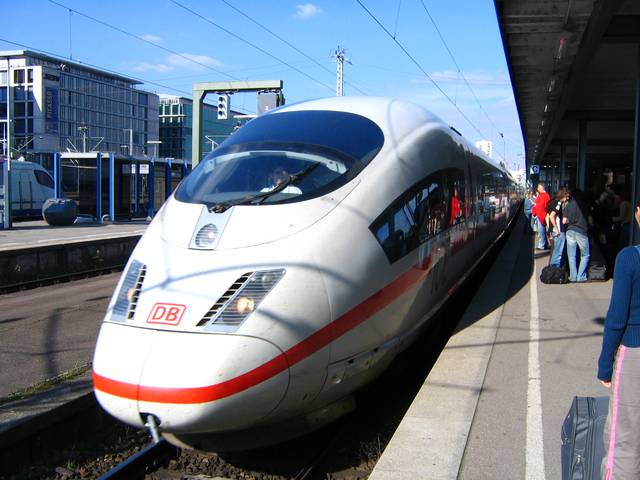
From main station Stuttgart Hauptbahnhof:
- to Cologne (Köln) 2hr 15min: (ICE via Mannheim, Frankfurt - traveling at up to 305 km/h)
- to Berlin 5hr 26min: (ICE via Göttingen - doesn't reach high speed on this track)
- to Frankfurt 1hr 26min. (Frankfurt Airport 1hr 15min; ICE direct)
- to Hamburg 5hr 8 min: (ICE via Hannover)
- to Mannheim 38min (ICE)
- to Munich (München) 2hr 11min: (ICE via Ulm, Augsburg - not top speed)
- to Nuremberg 2hr 10min (IC)
- to Freiburg/Br. 2hr 16min (IC via Karlsruhe).
From main station Stuttgart Hauptbahnhof:
- to Salzburg (Austria): 4hr 5min. (ICE)
- to Vienna (Austria): 6hr 32min. (IC, EN; via Munich and Salzburg)
- to Strasbourg (France) 1hr 20min (TGV),
- to Paris (France): 3hr 11min (TGV via Strasbourg) or 4 hours (ICE, change in Mannheim)
- to Zurich (Switzerland): 2hr 48min (ICE via Schaffhausen)
- to Amsterdam (Netherlands): 5hr 1min (ICE via Köln, Arnhem)
- to Prague (Czech Republic): 8hr 32 min (ICE, EC)
- to Brussels (Belgium): 4hr 49min (ICE, IC,Thalys)
